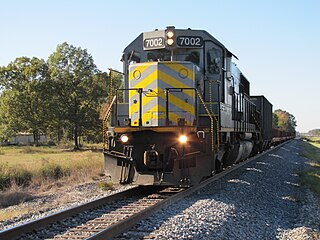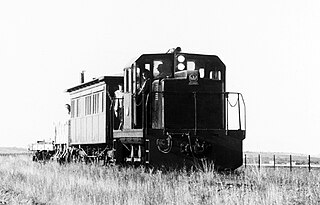
A bogie comprises two or more wheelsets, in a frame, attached under a vehicle by a pivot. Bogies take various forms in various modes of transport. A bogie may remain normally attached or be quickly detachable. It may include suspension components within it, or be solid and in turn be suspended. It may be mounted on a swivel, as traditionally on a railway carriage or locomotive, additionally jointed and sprung, or held in place by other means.

A steam locomotive is a locomotive that provides the force to move itself and other vehicles by means of the expansion of steam. It is fuelled by burning combustible material to heat water in the locomotive's boiler to the point where it becomes gaseous and its volume increases 1,700 times. Functionally, it is a steam engine on wheels.

A railcar is a self-propelled railway vehicle designed to transport passengers. The term "railcar" is usually used in reference to a train consisting of a single coach, with a driver's cab at one or both ends. Some railway companies, such as the Great Western, termed such vehicles "railmotors".

The New South Wales C38 class, occasionally known as the 38 class and nicknamed "Pacifics" by some railwaymen, was a class of 4-6-2 passenger steam locomotives built by Eveleigh Railway Workshops, Clyde Engineering and Cardiff Locomotive Workshops, for the New South Wales Government Railways in Australia.
The AAR wheel arrangement system is a method of classifying locomotive wheel arrangements that was developed by the Association of American Railroads. Essentially a simplification of the European UIC classification, it is widely used in North America to describe diesel and electric locomotives. It is not used for steam locomotives, which use the Whyte notation instead.

EMD E-units were a line of passenger train streamliner diesel locomotives built by the General Motors Electro-Motive Division (EMD) and its predecessor the Electro-Motive Corporation (EMC). Final assembly for all E-units was in La Grange, Illinois. Production ran from May 1937, to December, 1963. The name E-units refers to the model numbers given to each successive type, which all began with E. The E originally stood for eighteen hundred horsepower, the power of the earliest model, but the letter was kept for later models of higher power.
Early Electro-Motive Corporation switcher locomotives were built with Winton 201-A engines. A total of 175 were built between February 1935 and January 1939. Two main series of locomotives were built, distinguished by engine size and output: the straight-8, 600 hp (450 kW) 'S' series, and the V12, 900 hp (670 kW) 'N' series. Both were offered with either one-piece cast underframes from General Steel Castings of Granite City, Illinois, denoted by 'C' after the power identifier, and fabricated, welded underframes built by EMC themselves, denoted by 'W'. This gave four model series: SC, SW, NC and NW. Further developments of the 900 hp (670 kW) models gave model numbers NC1, NC2, NW1, and NW1A, all of which were practically indistinguishable externally from the others, as well as a pair of unique NW4 models for the Missouri Pacific Railroad and a solitary, twin-engined T transfer locomotive model built for the Illinois Central Railroad.

The EMD SD50 is a 3,500-horsepower (2,610 kW) diesel-electric locomotive built by General Motors Electro-Motive Division. It was introduced in May 1981 as part of EMD's "50 Series"; production ceased in January 1986. The SD50 was a transitional model between EMD's Dash 2 series which was produced throughout the 1970s and the microprocessor-equipped SD60 and SD70 locomotives. A total of 431 were built.

Baldwin Locomotive Works produced several different Baldwin DR-6 models of 6-axle passenger train-hauling diesel locomotives between 1945 and 1948. The series comprised eight individual versions, all of which sold only in small numbers; across all versions, only 39 locomotives were produced. Each version was produced only for a single railroad. Many shared the same Baldwin model number, DR-6-4-2000, even though they were rather different; this was because the Baldwin model only encoded the total axles (6), the driven axles (4) and the power output. The single exception was the single unit produced for the Chicago and North Western Railway, which had a single 1,000 hp (750 kW) engine and was model number DR-6-2-1000. In the AAR wheel arrangement scheme of classification, these locomotives were of A1A-A1A and A1A-3 arrangements, respectively.

The Detroit Diesel Series 71 is a two-stroke diesel engine series, available in both inline and V configurations, manufactured by Detroit Diesel. The number 71 refers to the nominal displacement per cylinder in cubic inches, a rounding off of 70.93 cu in (1.2 L).

F. C. Hibberd & Co Ltd was a British locomotive-building company founded in 1927 to build industrial petrol and diesel locomotives.

The S class are a class of diesel locomotives built by Clyde Engineering, Granville for the Victorian Railways between 1957 and 1961.

The Commonwealth Railways NC class consisted of two diesel-hydraulic locomotives built by Clyde Engineering, Granville, New South Wales in 1956. The Lakewood Firewood Company, Kalgoorlie was the first owner; the Commonwealth Railways purchased them in 1965. They ceased revenue service in the early 1980s.
The Rolls-RoyceC range was a series of in-line 4, 6 and 8 cylinder diesel engines used in small locomotives, railcars, construction vehicles, and marine and similar applications. They were manufactured by the Rolls-Royce Oil Engine Division headed by William Arthur Robotham to 1963, initially at Derby and later at Shrewsbury, from the 1950s through to 1970s.

The Ford A series is a range of trucks that was built by Ford UK to bridge the gap between the relatively small Transit of 3.5 metric tonnes GVW and the bigger 7-tonne D series.

The South African Railways Class 61-000 of 1959 was a diesel-hydraulic locomotive.

The FP paybuses were a series of thirteen small 4 wheel railbuses built for the Department of Railways New South Wales between 1937 and 1970. The rail buses were intended for use on branch lines whose low passenger numbers did not warrant the use of a larger railmotor.

The Lister Auto-Truck was a small monowheel tractor built for moving light loads around factories, railway yards and similar sites. They were based on a design originally by Auto Mowers Ltd, and were built by R A Lister and Company of Dursley, Gloucestershire, well known for their range of small stationary engines. A narrow-gauge rail version of the Auto-Truck was made along similar stylistic lines as regards the bonnetted engine, and its light weight made it popular for temporary and lightly laid tracks such as used on brickworks, peat bogs, and construction sites. Production of both the Auto-Truck and the Rail-Truck extended from the 1920s to the 1970s.

Rigid-framed electric locomotives were some of the first generations of electric locomotive design. When these began the traction motors of these early locomotives, particularly with AC motors, were too large and heavy to be mounted directly to the axles and so were carried on the frame. One of the initial simplest wheel arrangements for a mainline electric locomotive, from around 1900, was the 1′C1′ arrangement, in UIC classification.
The BHP Whyalla Tramway is a 1067 mm gauge heavy-haul railway, 112 kilometres long, on the Eyre Peninsula in South Australia. It runs from haematite mines at Iron Monarch, Iron Baron and Iron Duke in the Middleback Range, about 50 kilometres west of Whyalla, to company steelworks at the coastal city of Whyalla. Opened in 1901, it was built by, and until 2000 operated by, BHP. As of 2021 it was owned by Liberty Steel Group and operated on its behalf by rail operator One Rail Australia, which was sold in 2022 to Aurizon.















